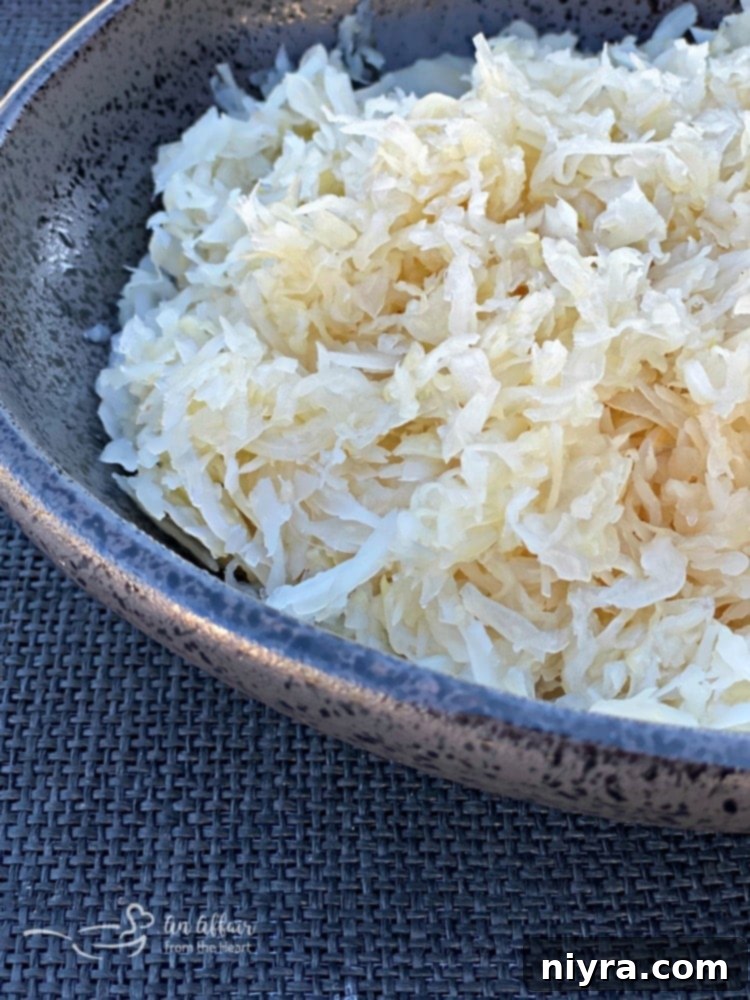With a rich tapestry of Polish and German heritage woven into my roots, it’s no surprise that I harbor a profound passion for kraut. Whether you prefer to call it sauerkraut or simply kraut, this fermented cabbage delicacy holds a special place in my heart and on my plate. The terms are indeed synonymous, both elegantly deriving from the German word for cabbage or herb, underscoring its historical connection to Central European cuisine. This humble yet incredibly versatile food is much more than a mere condiment; it’s a culinary cornerstone with a fascinating history and remarkable health benefits.

In recent years, sauerkraut has truly experienced a magnificent resurgence. If your perception of sauerkraut is limited to simply piling it onto a spicy Polish sausage at a ballgame, then you are genuinely missing out on a world of culinary possibilities! While a classic Reuben sandwich certainly highlights sauerkraut’s tangy charm, understanding the full depth of this fermented delight will elevate not just your Reuben sandwich, but countless other dishes.
Sauerkraut is far more versatile than many realize, gracing tables in a myriad of recipes spanning from comforting soups to vibrant salads, hearty entrees to intriguing appetizers. My collection boasts a wealth of kraut recipes, a testament to my unwavering enthusiasm. Indeed, it’s fair to say I am a truly big fan, and I’m eager to share why you should be too.
While my cultural heritage certainly predisposes me to a love for kraut, its appeal isn’t confined to a single lineage. This ancient method of preserving cabbage transcends borders and cultures. Take Korean kimchi, for instance. Though distinct in its spicy profile and ingredients, it shares the fundamental principle of lacto-fermented cabbage, making it kraut by another name in a different cultural context. This global presence underscores fermented cabbage’s universal appeal and health benefits, found in various forms across the world.

What Exactly is Sauerkraut? The Science Behind the Sour
At its core, sauerkraut is simply pickled cabbage. Its name, translated literally from German, means “sour cabbage,” a descriptor that perfectly captures its distinctive flavor profile. The signature sourness doesn’t come from vinegar, however, but from a natural process called lacto-fermentation. This begins when finely shredded cabbage is mixed with salt, which draws out water from the cabbage leaves. This water, forming a natural brine, dissolves the cabbage’s natural sugars.
Once submerged in this brine, beneficial lactic acid bacteria, naturally present on the cabbage, begin to thrive in the oxygen-free environment. These microscopic powerhouses feast on the dissolved sugars, converting them into lactic acid. This lactic acid is what gives sauerkraut its characteristic tangy taste and acts as a powerful natural preservative. This ingenious method allows the product to remain edible for months, or even years, when stored properly.
Beyond its flavor and preservation qualities, this lactic acid fermentation is a cornerstone of sauerkraut’s health benefits. The growth of these “healthy” bacteria, often referred to as probiotics, actively inhibits the proliferation of harmful bacteria and molds, including dangerous pathogens like botulism-causing organisms. This natural microbial ecosystem makes sauerkraut not just delicious, but incredibly safe and nourishing.
In this regard, sauerkraut shares fundamental similarities with other fermented foods. It mirrors cucumbers pickled in brine, which transform into crisp, tangy pickles. It also closely relates to kimchi, where cabbage is fermented in brine with a vibrant mix of red pepper and other spices. The key distinction for traditional sauerkraut is that it’s a non-heated method of pickling, relying entirely on microbial action rather than external heat or strong acids. While some modern sauerkrauts may incorporate vinegar for a quicker pickling process, this is not the traditional approach that harnesses the full power of fermentation.
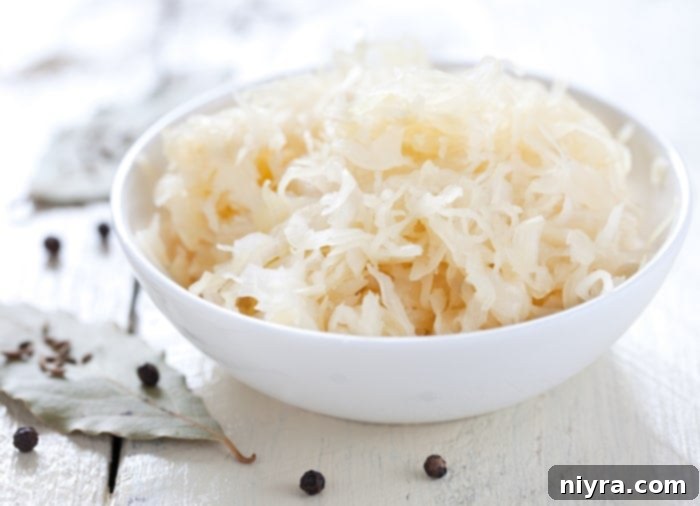
A Journey Through Time: The Rich History of Sauerkraut
While popular brands like Frank’s Kraut have delighted consumers for over a century, the history of sauerkraut stretches back millennia, making Frank’s a mere blip in its vast timeline. This ancient food preservation technique has roots far deeper than many might imagine.
Although Germans, Poles, and Czechs are famously passionate about their kraut – and my family’s multi-generational Polish recipes certainly attest to this enduring love – sauerkraut’s origins most likely trace back to ancient Asia. Historians suggest that fermented cabbage first emerged in China over 2,000 years ago. It is believed that laborers building the Great Wall of China were fed fermented cabbage and rice wine to sustain them through their grueling work. From there, it wasn’t the Europeans who initially popularized it, but rather the formidable Mongol empire.
That’s right, legendary figures like Genghis Khan and his grandson Kublai Khan are credited with introducing fermented cabbage to new regions. As their vast armies swept across Asia and into Eastern Europe, they carried this nutritious, long-lasting food with them. Sauerkraut became a crucial part of their diet, providing essential nutrients and preventing illness during their extensive campaigns. This spread facilitated the introduction of fermented cabbage to what would become Germany and other Central European nations, where it was eagerly adopted and integrated into local culinary traditions, evolving into the sauerkraut we recognize today. Its practicality and nutritional value made it an indispensable staple, especially in times of war and long journeys, long before it became a culinary delight.
It’s a fascinating thought that while these empires were engaged in conquest and expansion, they were simultaneously spreading a culinary innovation that would endure for centuries. The humble cabbage, transformed by salt and time, truly has a global story to tell.
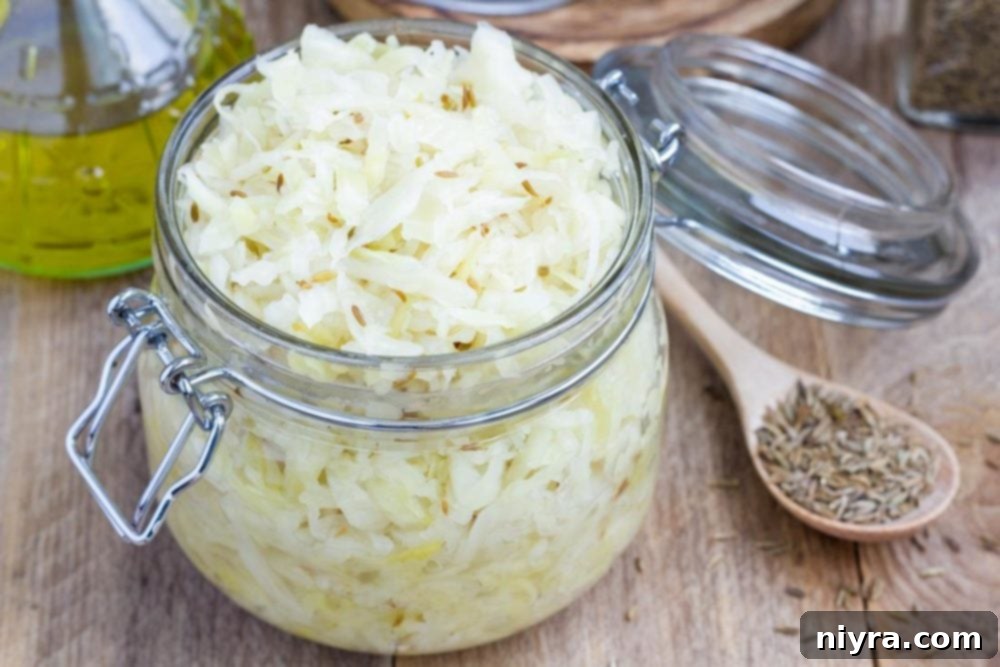
Pasteurized vs. Unpasteurized Kraut: Understanding the Difference
When you browse the aisles of your local market today, you’ll likely encounter both pasteurized and unpasteurized sauerkraut. While both versions can be a delicious addition to your diet, there’s a significant difference in their health benefits, particularly regarding their probiotic content.
Unpasteurized sauerkraut is a living food, teeming with the same healthy bacteria that drove its fermentation. These live and active cultures are the true stars, offering powerful probiotic benefits similar to those found in high-quality yogurts. Identifying unpasteurized sauerkraut is quite simple: check the ingredients list. If it contains only cabbage, water, and salt, or perhaps a few natural spices, then you’ve found the real deal – a raw, probiotic-rich product that’s often found in the refrigerated section of the grocery store.
On the other hand, if the ingredients list includes vinegar or other preservatives, it typically indicates that the sauerkraut has been pasteurized. Pasteurization is a heating process designed to kill bacteria, which extends shelf life and ensures product stability at room temperature. However, this heat also eliminates the very beneficial live cultures that make unpasteurized sauerkraut so incredibly good for you. To compensate for the loss of these natural preservatives (the healthy bacteria themselves), manufacturers often add vinegar or other acidic agents to maintain flavor and prevent spoilage. While still a tasty food, pasteurized sauerkraut lacks the probiotic punch that its raw counterpart offers.
The healthy bacteria in unpasteurized kraut do more than just inhibit mold growth and act as natural preservatives; they actively contribute to a thriving gut microbiome. This intricate ecosystem of microorganisms in your digestive tract plays a vital role in everything from nutrient absorption and digestion to immune system function and even mental health. Multiple peer-reviewed studies have even shown that the compounds produced during the fermentation of cabbage, along with the beneficial bacteria themselves, may help inhibit the growth of certain cancer cells, underscoring the profound therapeutic potential of this traditional food.
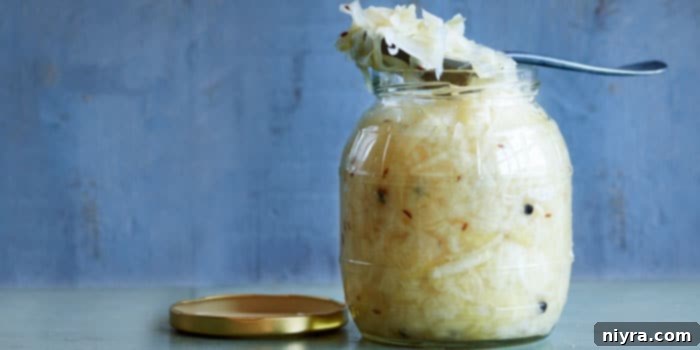
The Remarkable Health Benefits of Sauerkraut
Sauerkraut, in both its pasteurized and unpasteurized forms, is packed with an impressive array of nutrients. It’s an excellent source of vitamins C and K, rich in dietary fiber, and naturally low in sugar. For centuries, sauerkraut has been revered as a folk remedy, used to treat a variety of ailments and support overall well-being. Modern science is increasingly catching up, validating many of these traditional wisdoms with compelling research.
Beyond the basic nutritional profile, raw, unpasteurized sauerkraut offers an exceptional boost from its live probiotic cultures. These beneficial bacteria contribute significantly to a healthy gut microbiome, which is foundational to holistic health. A robust gut is linked to improved digestion, enhanced nutrient absorption, and a stronger immune system, making you more resilient against illness. The fermentation process also increases the bioavailability of certain nutrients, meaning your body can absorb and utilize them more efficiently.
Furthermore, sauerkraut is a good source of various antioxidants and minerals that help combat oxidative stress and inflammation in the body. Its high fiber content aids regularity and can help regulate blood sugar levels. Incorporating this fermented superfood into your regular diet can be a simple yet powerful step towards enhancing your overall health and vitality, proving that sometimes, the simplest foods offer the most profound benefits. It’s always satisfying when ancient traditions are affirmed by contemporary scientific understanding, isn’t it?
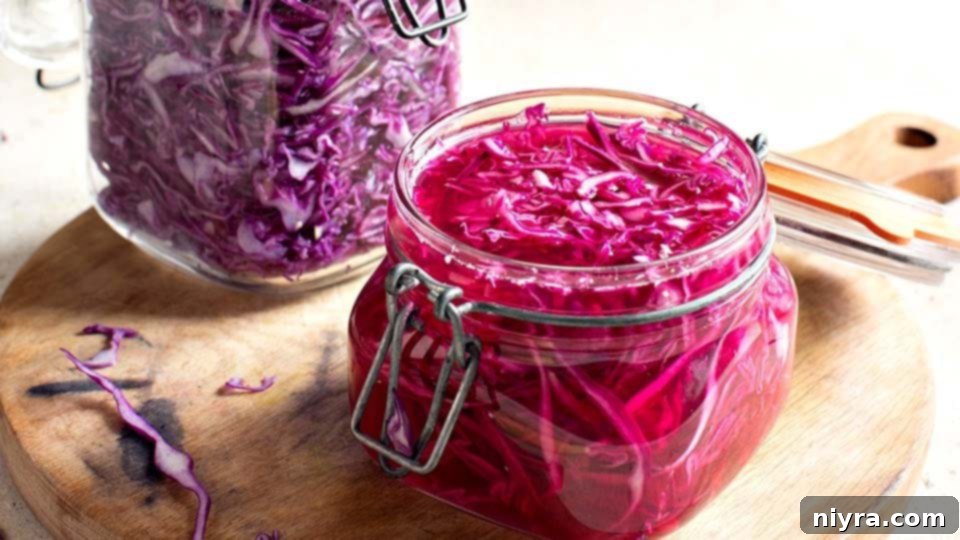
Exploring the Many Delicious Variations of Sauerkraut
While classic sauerkraut is typically made with finely shredded green cabbage and salt, the world of fermented cabbage is incredibly diverse. Sauerkraut doesn’t necessarily have to be confined to a single formula; different cultures and regions have developed their own delightful variations, showcasing the incredible adaptability of this simple food.
In Poland, for instance, a common and beloved variation of kraut is made not only with shredded cabbage but also with shredded carrots. The carrots add a touch of sweetness and a vibrant orange hue, balancing the sourness of the cabbage beautifully. Another popular Polish variety incorporates beets, which lend a striking ruby-red color and an earthy sweetness to the kraut, making it as visually appealing as it is flavorful.
Across the border in Germany, it’s common to find cooked sauerkraut seasoned with aromatic additions like caraway seeds and juniper berries. These spices infuse the kraut with a deeper, more complex flavor profile, often served alongside rich pork dishes. In the Alsatian region of France, which shares strong German culinary influences, traditional recipes for choucroute garnie often include potatoes along with the sauerkraut, creating a heartier, more substantial dish.
Beyond these regional specialties, kraut can be innovatively integrated into a vast array of dishes. It can be mixed into savory meatballs, as I often do with my own meatball kraut recipe, which I adore serving. This is an especially clever way to introduce sauerkraut to skeptics or those who claim to dislike it. Just be sure not to reveal the secret ingredient until after they’ve raved about how delicious it is! The subtle tang and added moisture from the kraut can transform ordinary dishes into something truly extraordinary.

A Step-by-Step Guide to Making Your Own Homemade Sauerkraut
Embarking on the journey of making your own sauerkraut is a rewarding experience that yields a truly fresh, probiotic-rich product. The process is surprisingly simple, requiring just a few basic tools and ingredients: mason jars, pickling salt, water, and, of course, fresh shredded cabbage.
First, ensure that your mason jars and their lids are thoroughly sterilized. You can achieve this by washing them in hot, soapy water or running them through a dishwasher on a hot cycle. Allow them to cool completely before use; you want to create a clean, safe environment for the beneficial bacteria to thrive, but not so hot that it kills them immediately. Next, prepare your cabbage by removing any damaged outer leaves, quartering it, and then shredding it finely. A mandoline or food processor can make this task much easier.
Now, it’s time to build your kraut. In a large bowl, combine the shredded cabbage with pickling salt. The general rule of thumb is about one to three tablespoons of pickling salt per five pounds of cabbage. Massage the salt into the cabbage vigorously for 5-10 minutes. This step is crucial as it helps break down the cabbage cells, allowing it to release its natural juices. You’ll notice the cabbage becoming softer and a good amount of liquid pooling at the bottom of the bowl.
Begin tightly packing the cabbage mixture into your sterilized mason jars, pressing down firmly with your fist or a kraut pounder after each addition. The goal is to eliminate any air pockets. Once the jar is nearly full, pour the liquid that accumulated in the bowl over the cabbage. The most critical aspect of successful fermentation is keeping the cabbage completely submerged beneath the brine solution. Exposure to air can lead to mold growth. If the cabbage doesn’t produce enough of its own liquid to cover itself, you’ll need to create a simple brine by dissolving one to three tablespoons of pickling salt per quart of non-chlorinated water and adding it until the cabbage is fully submerged. You might need to use a “fermentation weight” – typically a piece of glass designed to fit inside the jar – to hold the cabbage down. These weights resemble small, clear hockey pucks and are indispensable for keeping your kraut safe and mold-free. You can usually find them alongside mason jars and other canning supplies.
Once the cabbage is submerged, securely seal your lid (some prefer airlock lids, but a standard lid will work, just ‘burp’ it occasionally). Store the jars in a cool, dark place away from direct sunlight or heat sources like a stove or heater. Ideal temperatures for fermentation are generally between 60-75°F (15-24°C). Allow the jars to sit for at least two weeks, though many prefer to let them ferment for much longer – anywhere from three weeks to several months – for a more complex flavor. The beauty of fermentation is its longevity!
After the desired fermentation period, open your jar, enjoy the distinct aroma, and taste your homemade creation. You’ll not only savor a healthy and delicious food but also take immense pride in having crafted something so simple, yet so profoundly beneficial, with your own hands!
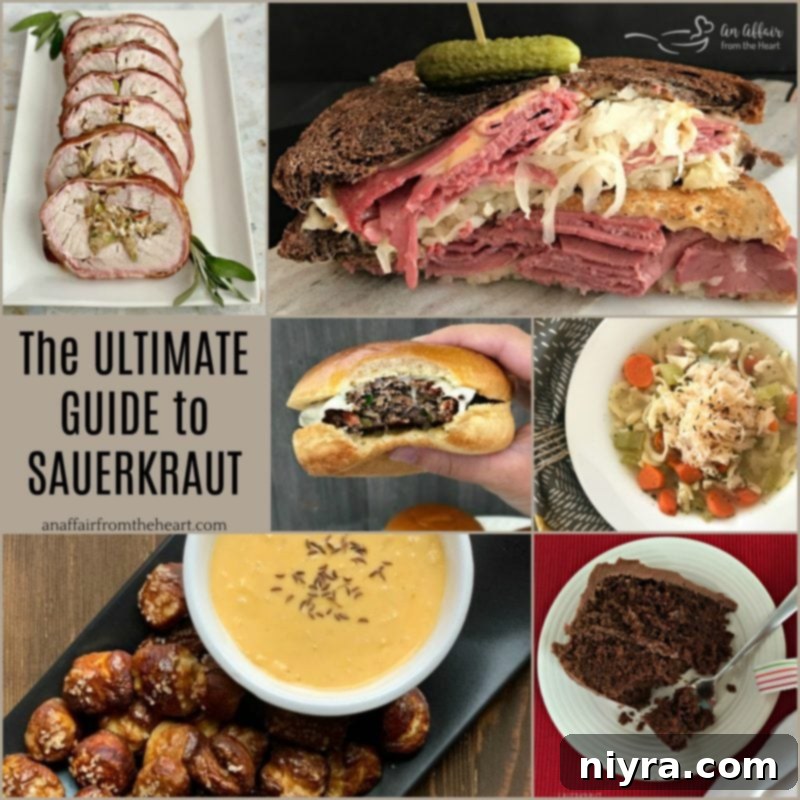
Unleashing the Flavor: Incredible Sauerkraut Recipes!
Now, this brings me to what I consider the most exciting part: showcasing sauerkraut’s incredible potential in a wide array of dishes! As I mentioned earlier, I am a devoted fan of Frank’s Kraut, largely due to its consistent quality, perfect texture, and ideal tang that integrates beautifully into recipes. However, feel absolutely free to use any other brand you love, whether it’s pasteurized or unpasteurized, or better yet, take pride in using your very own homemade batch.
All I ask – and I am truly asking nicely here – is that you please stop thinking of sauerkraut as merely a topping for a hot dog or a side for a simple sausage. While there’s no denying the classic pleasure of a great dog piled high with kraut and mustard, that’s just the tiniest peek into the vast culinary world that awaits. Any dish that has been passed down and evolved for thousands of years is bound to have developed into an incredible variety of delicious cuisines and innovative applications. Even over a thousand years ago, creative chefs undoubtedly grew bored with the “same old, same old” and began experimenting, adding fun and flavorful twists to their favorite fermented foods. It’s time we embrace that same spirit of culinary adventure!
Let’s move beyond the stereotypes and explore how sauerkraut can truly transform your cooking, bringing its unique tangy brightness and probiotic goodness to every meal. Prepare to be inspired by these fantastic recipes.
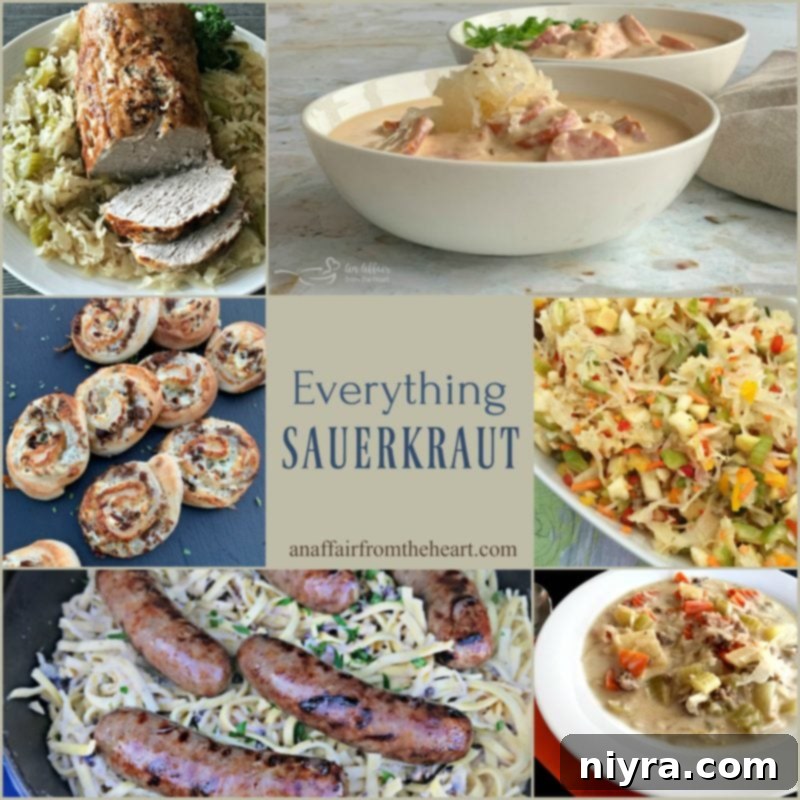
A Collection of Family Favorites and Culinary Discoveries
Here is a mix of some cherished family recipes passed down through generations and a few other innovative dishes I’ve learned to love along the way. Each one showcases sauerkraut’s amazing versatility and flavor contribution.
- Bacon Wrapped Pork Loin with Sauerkraut Stuffing – This is an absolutely classic Polish dish, a testament to the perfect synergy between pork and kraut. If you already suspected they go well together, prepare to multiply that by ten. Bacon and sauerkraut together? It’s like chocolate and peanut butter, or vodka and your favorite mixer – they are truly meant for each other, creating a symphony of savory and tangy flavors.
- Instant Pot Beer Cheese Soup with Sauerkraut and Kielbasa – A hearty German-inspired dish that pairs exceptionally well with a crisp beer, especially a German lager. The sauerkraut adds a delightful tang that cuts through the richness of the cheese and kielbasa, creating a perfectly balanced and deeply satisfying soup.
- Quick Pretzel Bites with Sauerkraut – Imagine warm, soft pretzel bites, dipped in mustard, and then topped with a spoonful of tangy sauerkraut. This is an excellent, surprisingly healthy snack or a fantastic appetizer. It also makes a superb side dish for your beer cheese soup or the bacon-wrapped pork!
- Steak and Kraut Pinwheels with Caramelized Onions and White Cheddar Cheese – Thought kraut was only destined for pork sausages like bratwurst? Think again! Sauerkraut offers a bright, savory counterpoint to rich steak, especially when combined with sweet caramelized onions and sharp white cheddar in these elegant and flavorful pinwheels.
- Spicy Bacon Kraut Burger – Of course, I had to find a way to marry kraut to a burger! This recipe takes a classic burger to the next level by incorporating the incredible duo of bacon and sauerkraut. It’s like a celebrity couple whose marriage has lasted over 20 years – a truly miraculous and unbelievably delicious combination.
- Kraut Stuffed Bacon Wrapped Brats – Alright, did you really think I wouldn’t include a quintessential bratwurst and kraut recipe? This one elevates the experience by stuffing the brat with kraut and then wrapping it in bacon, creating an explosion of flavor and texture in every bite.
- Creamy Kraut and Mushroom Noodles – This comforting dish features a luxurious creamy mushroom sauce intertwined with delicious Frank’s kraut and tender noodles. My family absolutely adores this unique and satisfying meal that perfectly blends earthy and tangy notes.
- Homemade Chicken Noodle Soup with Sauerkraut – Another classic German dish, this version of chicken noodle soup is often heralded as the ultimate comfort food. When people talk about chicken soup being a cure-all for colds and flu, I’m pretty sure this robust, flavorful, and slightly tangy sauerkraut-infused version is what they’re referring to.
- Pork Roast with Sauerkraut – This is a time-honored traditional favorite that you’d be hard-pressed to find a German restaurant without. If it’s not on the menu, you have every right to call the cuisine police immediately – it’s that iconic! The slow-roasted pork becomes incredibly tender, complemented perfectly by the sharp, savory kraut.
- Sauerkraut Meatballs – A delightful and unexpected twist on classic meatballs. These savory bites are fantastic as an appetizer or a main course, and they’re guaranteed to surprise and impress your guests with their unique flavor profile.
- Sauerkraut Chocolate Cake – Don’t knock it until you’ve tried it! This might sound unconventional, but the sauerkraut adds an incredible moistness and subtle tang that makes this hands down the best chocolate cake I have ever eaten. It’s a true culinary revelation!
So, if you ever confined sauerkraut to just topping a Polish dog at a game, you now know that its culinary potential is truly boundless. I wholeheartedly encourage you to dive into my diverse collection of Kraut Recipes, and perhaps even embark on a little experimentation of your own. Stay with me, because I am always discovering and creating new sauerkraut recipes to share with you! For even more delicious ideas and inspiration, be sure to follow my dedicated Sauerkraut Board on Pinterest.

